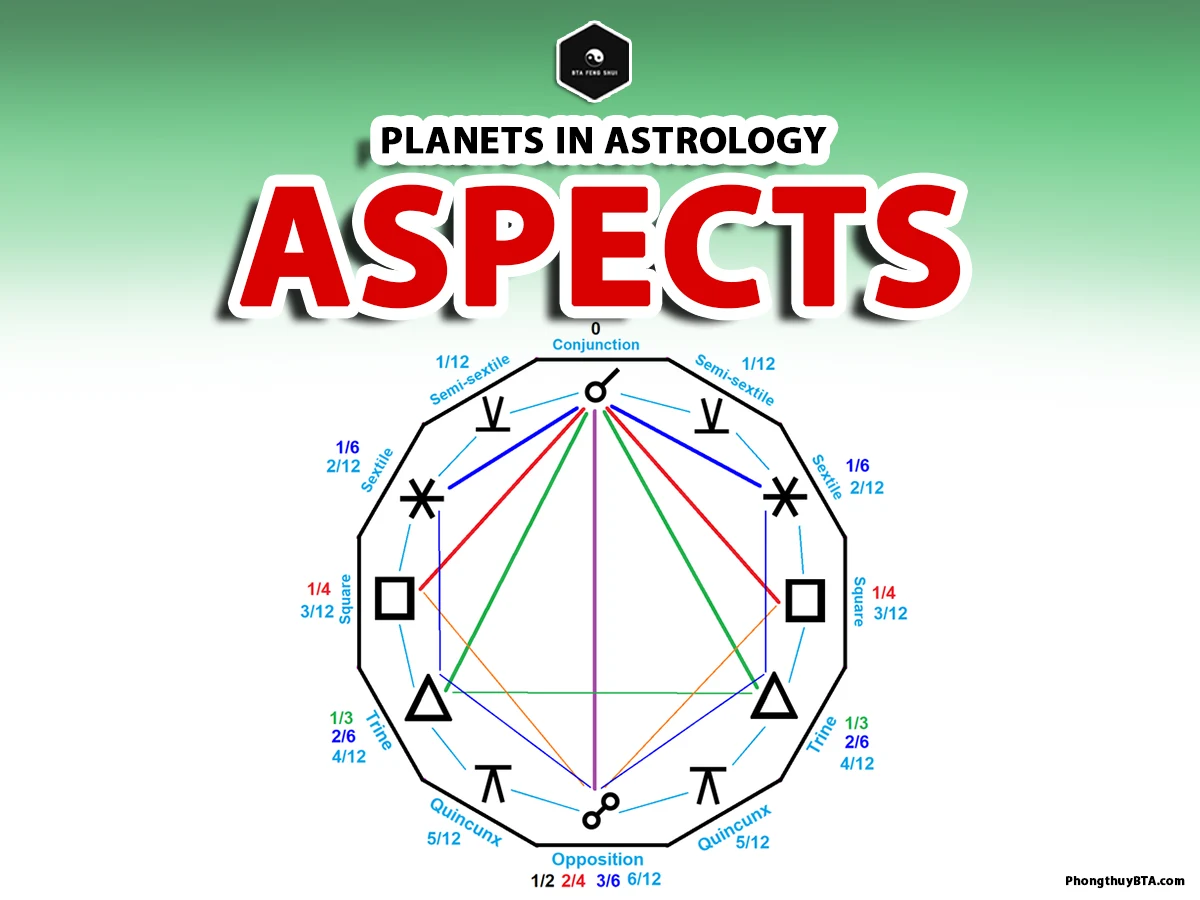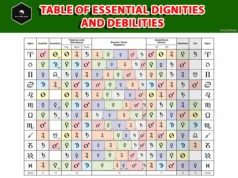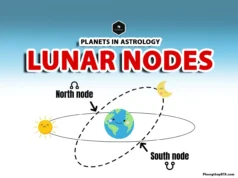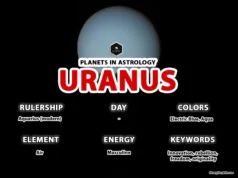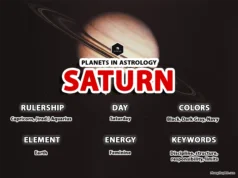Ever wondered why some relationships are easy while others are full of friction? In Western astrology, astrological aspects show the angles between planets in your birth chart, influencing personality, challenges, and growth.
These aspects act like cosmic conversations—either harmonious or tense—that affect everything from emotions to career. Understanding them helps you decode your chart and gain deeper insights into life. Let’s explore their meanings and impact!
See the chart below for a quick guide to aspect angles, orbs, and meanings:
| Symbol | Aspect | Angle / Orb | Keyword |
|---|---|---|---|
| ☌ | Conjunction | 0° ± 8° | Blending |
| ☍ | Opposition | 180° ± 8° | Dynamic (Challenging) |
| △ | Trine | 120° ± 8° | Flowing (Easy) |
| □ | Square | 90° ± 8° | Dynamic (Challenging) |
| ⚹ | Sextile | 60° ± 6° | Flowing (Easy) |
| ⚻ | Inconjunct | 150° ± 4° | Adjustment |
| ✶ | Quintile | 72° ± 2° | Creative Flow |
| ⚺ | Semi-Sextile | 30° ± 2° | Minor Adjustment |
| ⚼ | Semi-Square | 45° ± 2° | Tension |
| ⚽ | Sesquiquadrate | 135° ± 2° | Dynamic (Challenging) |
What Are Aspects in Astrology?
Aspects in astrology are precise angular relationships between planets, points, or house cusps measured along the ecliptic. Viewed from Earth, they range from 0° (conjunction) to 180° (opposition), with allowable “orbs” determining strength—the tighter the angle, the more potent the influence.
Think of your chart as a celestial orchestra: planets are musicians, signs their instruments, houses the stage, and astro aspects the harmonies or discords. Without them, traits exist in isolation; with them, life gains interplay and evolution. Aspecting astrology highlights how energies blend, clash, or support, turning static positions into a living story.
Why Aspects Matter in Your Natal Chart
In a birth chart aspects analysis, these connections predict relational dynamics, inner conflicts, and talents. A challenging aspect in astrology like a square pushes growth through tension, while easy ones like trines offer natural gifts. Mastering astrology natal chart aspects helps interpret why you attract certain people or face recurring themes.
Astrology Aspect Symbols and Meanings
Astrology aspect symbols use lines and glyphs in charts: red for tension, blue/green for harmony. Here’s a breakdown of major aspects astrology symbols and their core interpretations:
- Conjunct astrology (☌, 0°): Fusion of energies; amplifies traits but can overwhelm if unbalanced.
- Sextile (✻, 60°): Opportunities through cooperation; stimulating yet gentle.
- Square (□, 90°): Internal friction driving action; builds resilience.
- Trine (△, 120°): Flowing talents; effortless but risks complacency.
- Opposition (☍, 180°): Polarities seeking balance; often projected onto relationships.
These astrological aspect symbols appear in astrology aspects charts, with orbs varying by planet luminosity—Sun/Moon up to 12°, others 6-8°.
Ptolemaic Aspects: The Core Five
Rooted in ancient tradition, these astrology planetary aspects form the foundation. Ptolemy’s framework divides the 360° circle meaningfully.
Conjunction in Astrology: Unified Power
Conjunct astrology meaning involves planets at the same degree, blending essences. Benefic (e.g., Venus-Jupiter) boosts luck; malefic (Mars-Saturn) intensifies struggles. Cazimi (within 0°17′ of Sun) elevates a planet to “royal” status, while combust (8-17° from Sun) weakens it.
Sextile: Harmonious Opportunities
A 60° angle fosters creativity and communication. Unlike trines, sextiles require activation—think Venus sextile Mars sparking passionate pursuits with effort.
Square: Dynamic Tension for Growth
At 90°, squares create crossroads. Mars square Pluto? Intense power struggles yield transformation. They demand awareness to avoid repetitive cycles.
Trine: Natural Flow and Talents
120° connections gift innate abilities. Jupiter trine Mercury eases learning, but over-reliance breeds laziness. Ground them consciously.
Opposition: Mirrors and Balance
180° polarizes energies, often externalized in partnerships. Sun opposite Moon highlights self vs. emotions, teaching integration through compromise.
Minor Aspects in Astrology: Subtle Nuances
Minor aspects astrology add layers, with tighter orbs (1-3°). They refine interpretations without dominating.
| Aspect | Degrees | Keyword | Influence |
|---|---|---|---|
| Semi-sextile | 30° | Adjustment | Minor growth through irritation |
| Quincunx (Inconjunct) | 150° | Redirection | Karmic shifts; health or crisis prompts change |
| Quintile | 72° | Genius | Creative sparks; unique talents |
| Semi-square | 45° | Friction | Petty annoyances building pressure |
| Sesquiquadrate | 135° | Agitation | Persistent nudges for resolution |
Minor astrology aspects like quintiles reveal hidden ingenuity, often overlooked in basic readings.
Orbs, Applying, and Separating Aspects
Orbs define aspect strength: wider for luminaries, tighter for minors. Applying aspects (approaching exact) build future intensity; separating fade but leave residue. In transits, applying squares signal upcoming tests.
Unaspected Planets and Void-of-Course Moon
An unaspected planet operates independently—pure but isolated, like Mercury unaspected yielding brilliant yet detached thinking. A void-of-course Moon in natal charts suggests emotional pauses, craving introspection before new cycles.
Interpreting Aspects in Your Birth Chart
Context is key: house rulers, elements, and modalities color planet aspects. Fire trines ignite passion; earth squares ground ambitions. Analyze patterns—grand trines for talent triangles, T-squares for focal drive.
Astrology aspects explained: Challenging ones (squares, oppositions) forge character; harmonious (trines, sextiles) provide support. No aspect is “bad”—all teach. A stellium with mixed aspects? Concentrated themes demanding balance.
Aspect Patterns: Advanced Insights
- Grand Cross: Four squares/oppositions; crossroads of crises yielding mastery.
- Yod (Finger of Fate): Two quincunxes to a focal planet; destiny’s nudge.
- Kite: Trine-sextile-opposition; directed flow from opposition.
Aspects Astrology in Practice
Beyond theory, astrograph birth chart tools visualize these. In synastry, Venus-Mars aspects predict chemistry; composite charts show relationship dynamics. Progressions evolve natal aspects over time.
What do aspects mean in astrology? They’re life’s blueprint for relating—to self, others, and the universe. Embrace tension for evolution; leverage ease for joy.
Ready to dive into your chart? Explore aspects symbols in astrology and unlock potentials. Rate this guide 5 stars and share with fellow stargazers!



